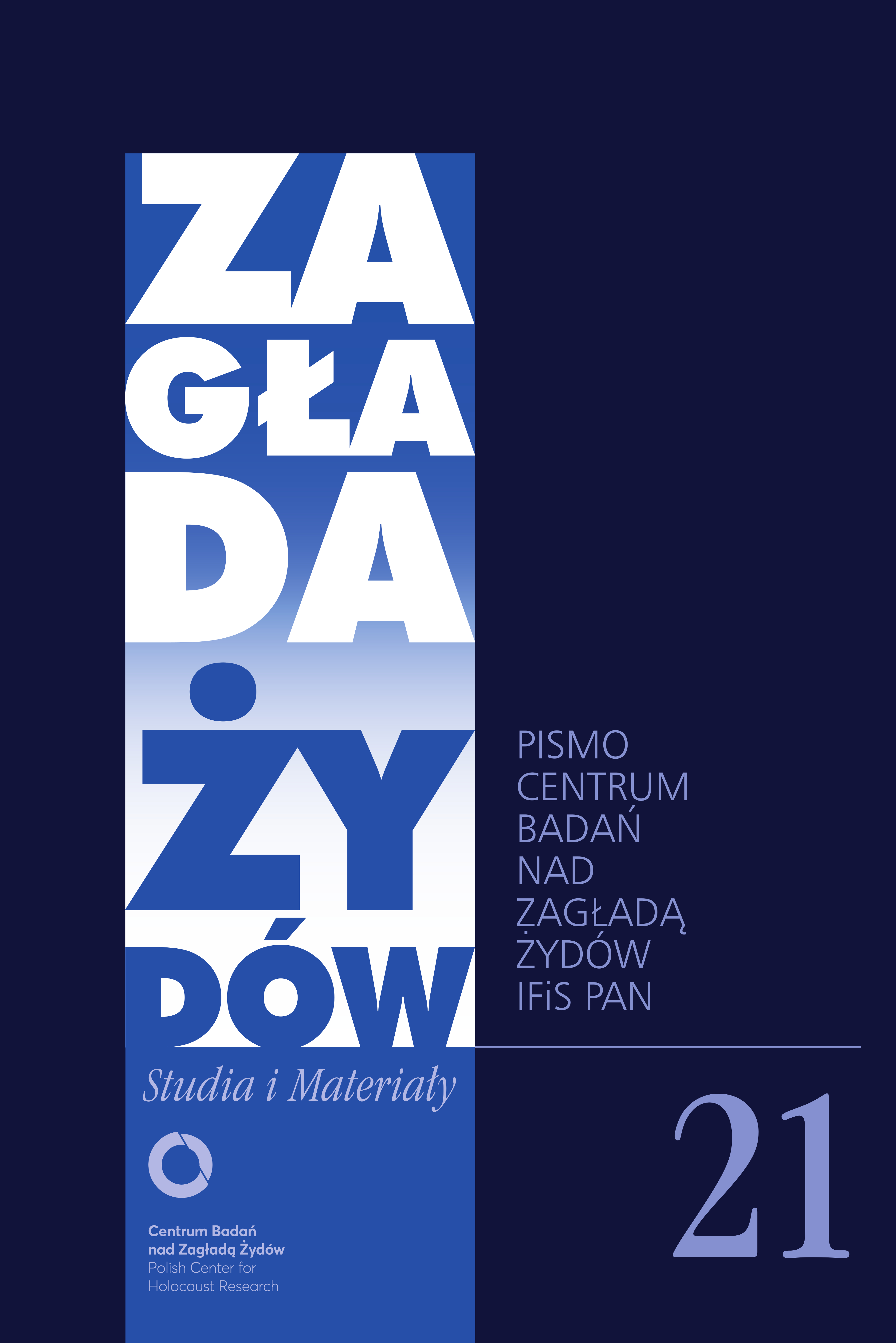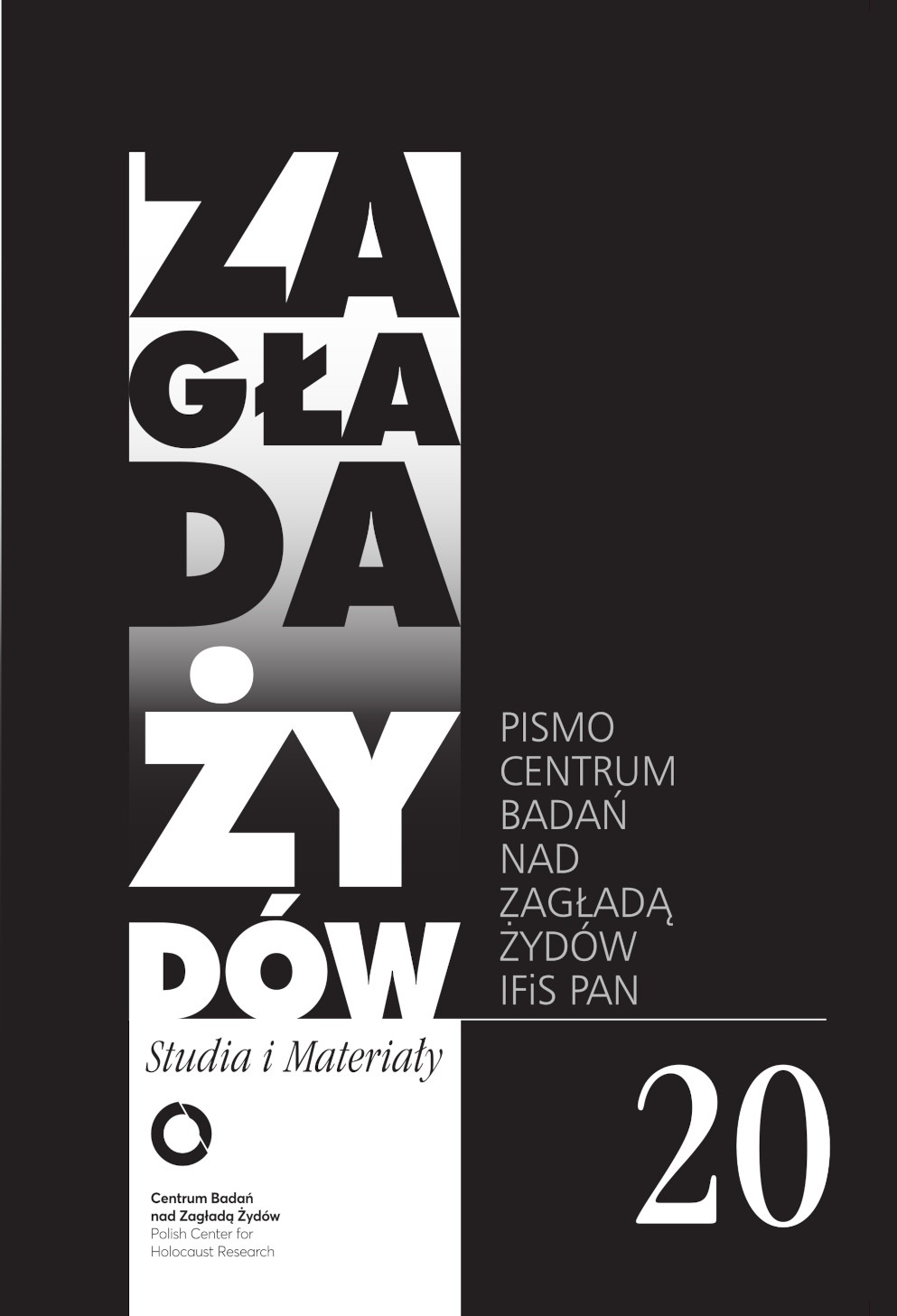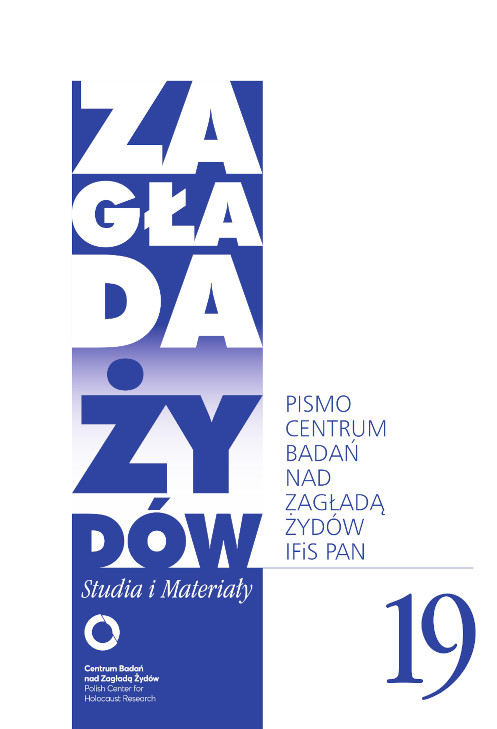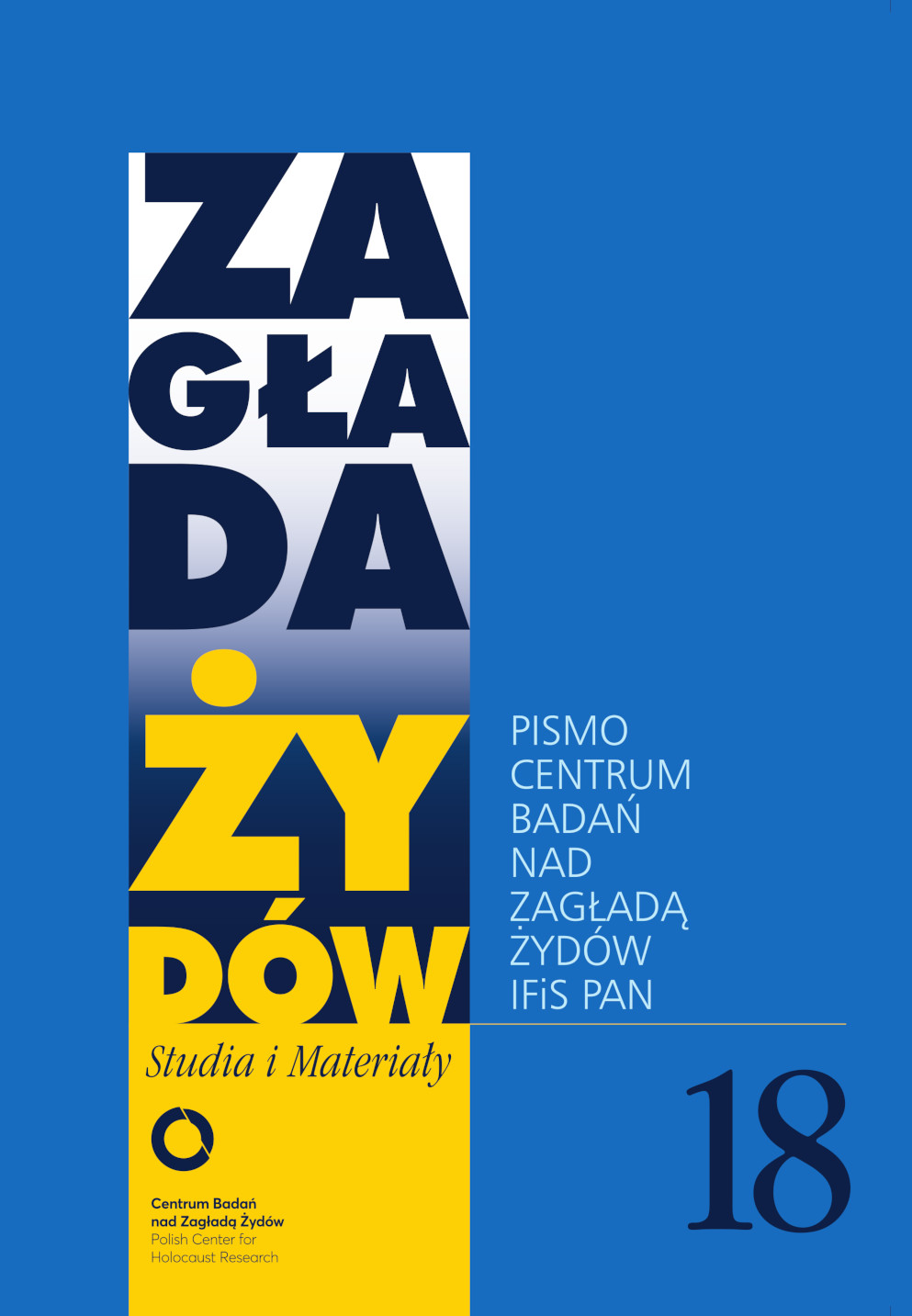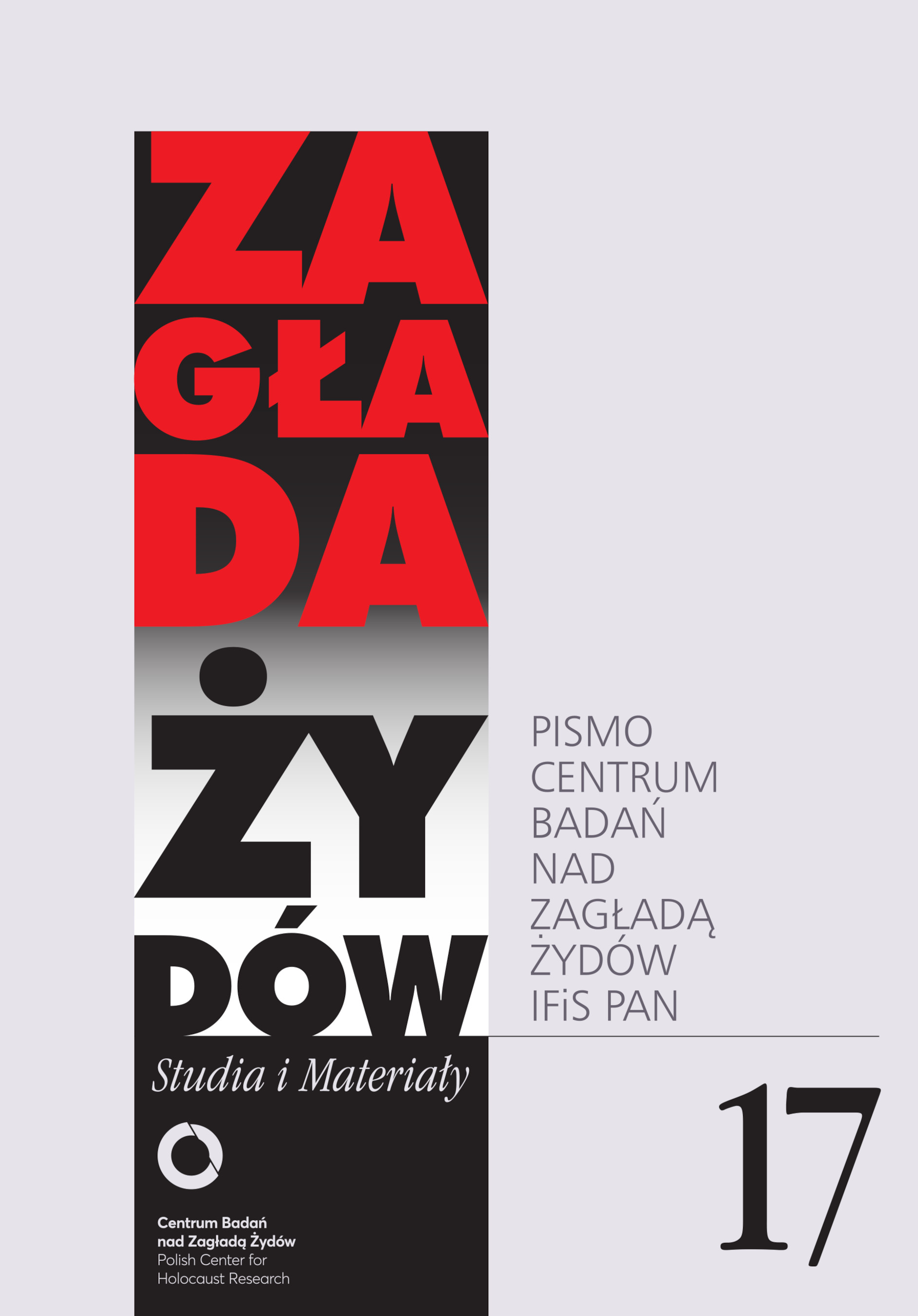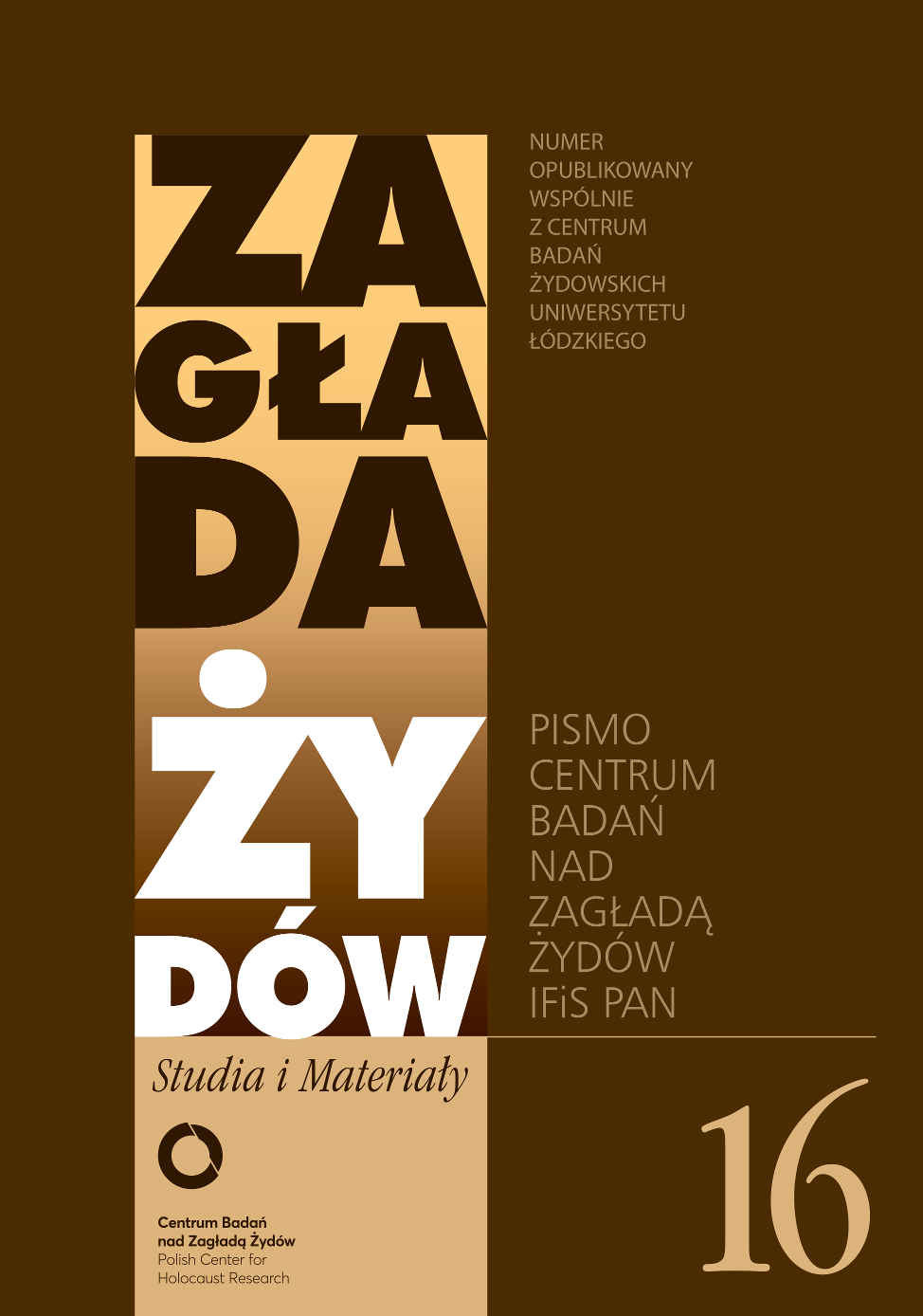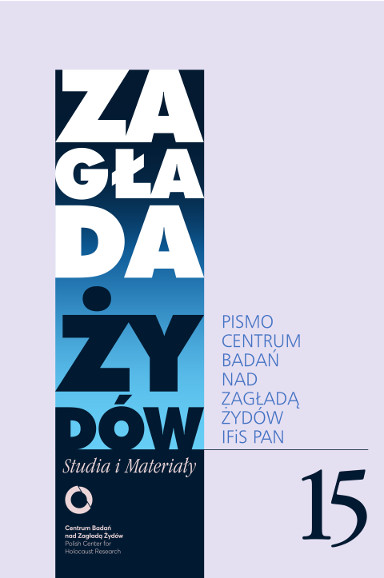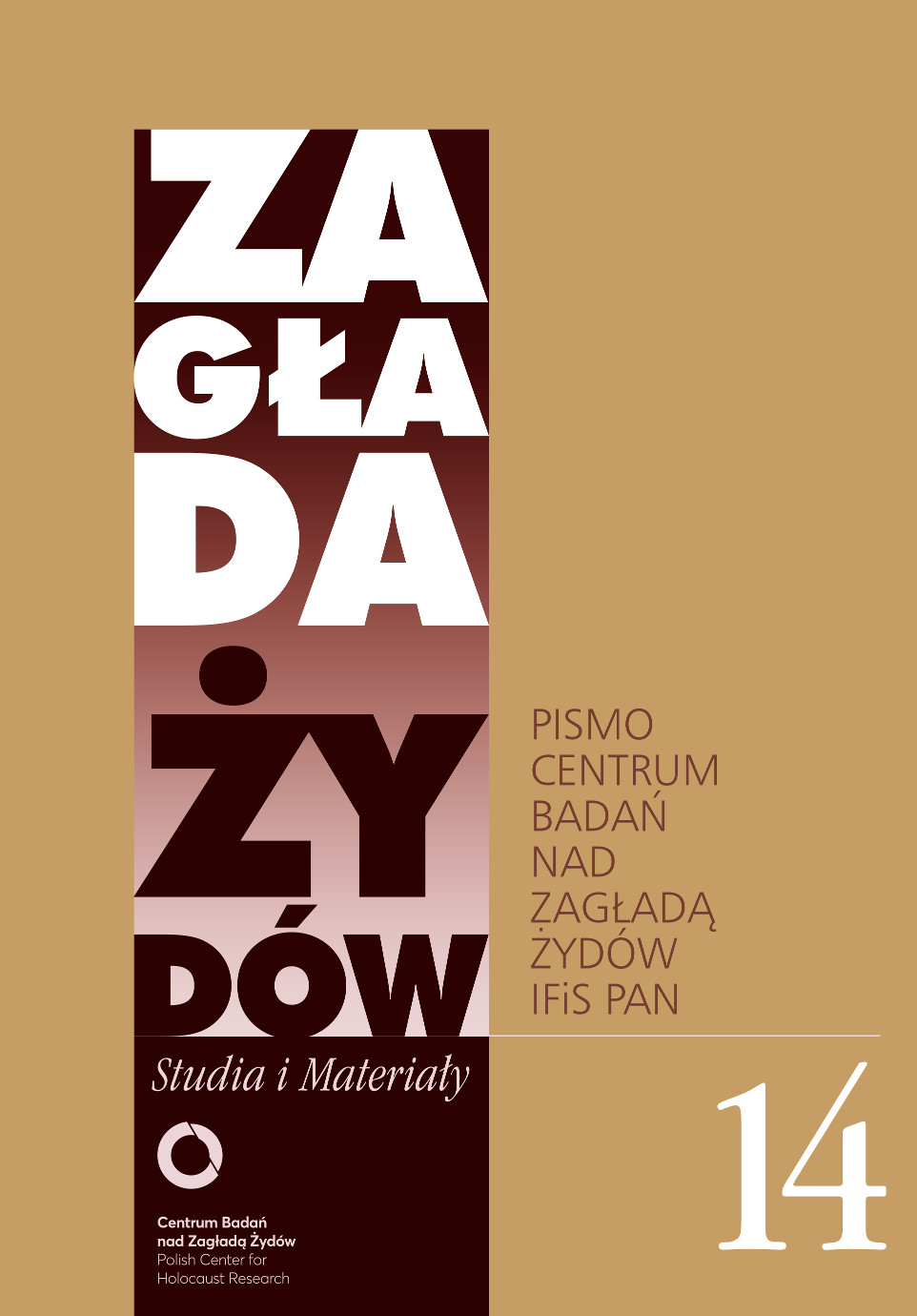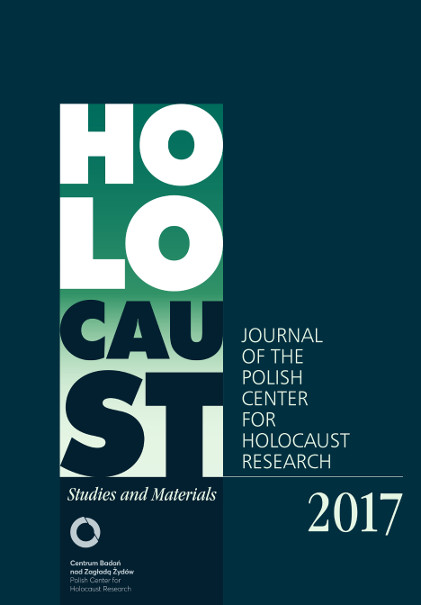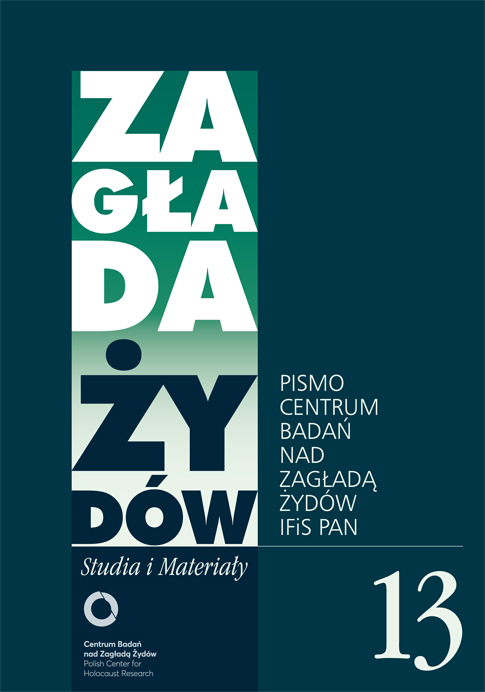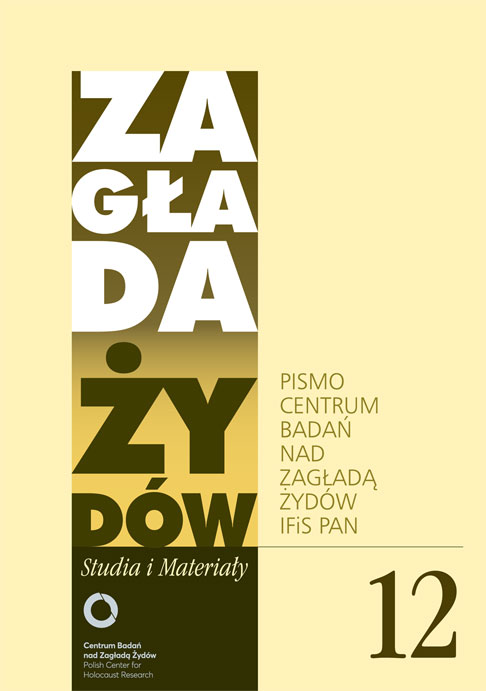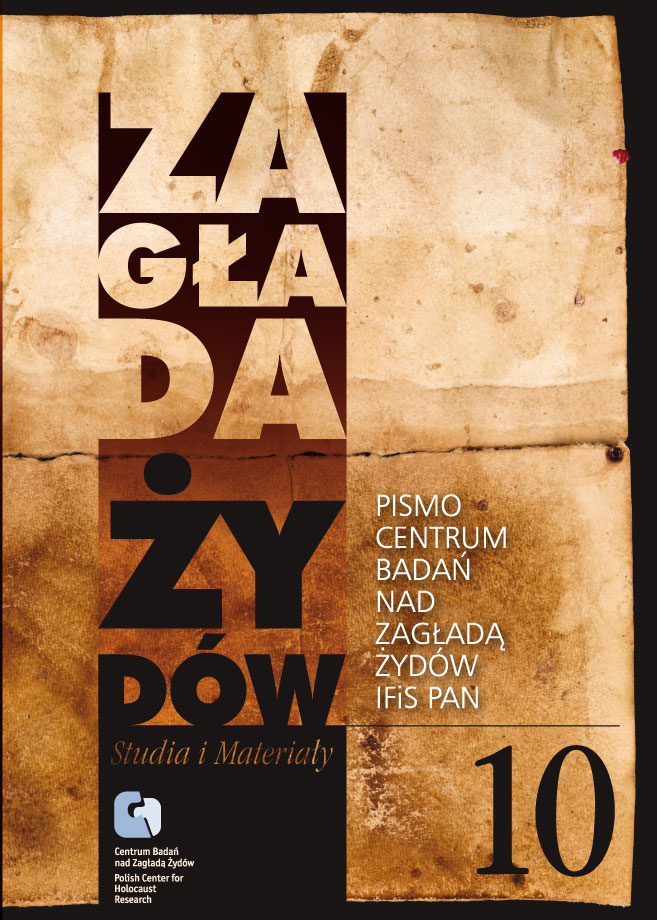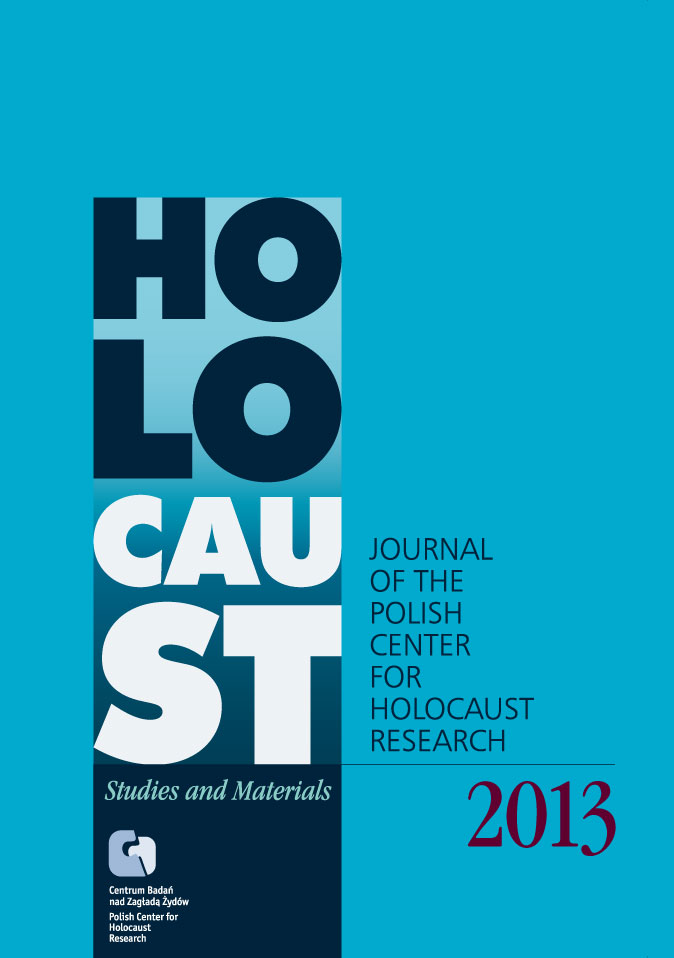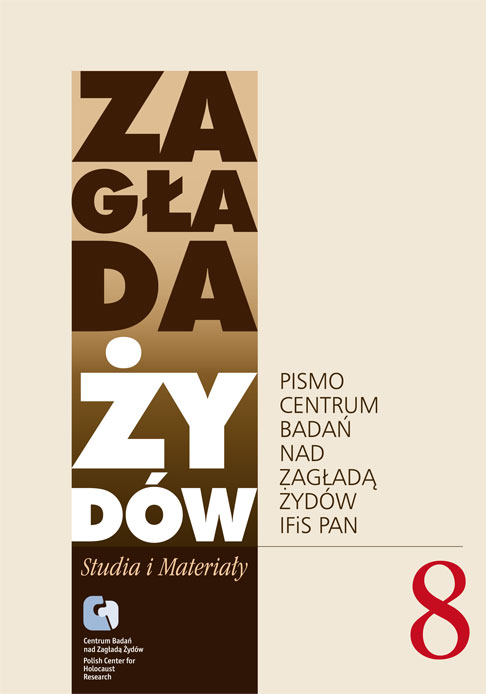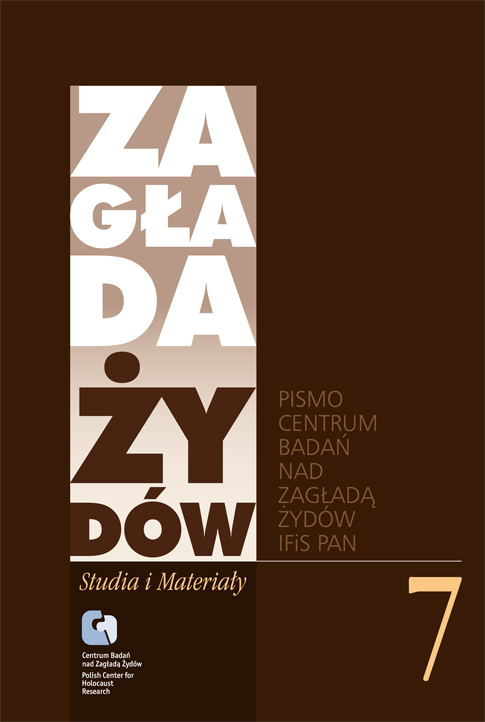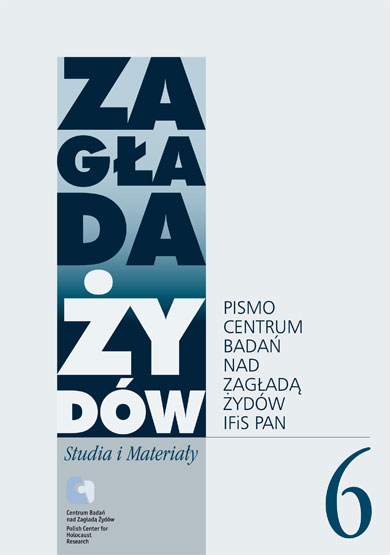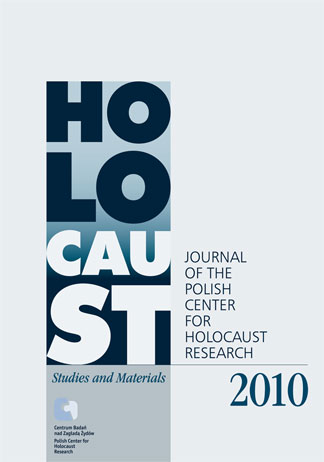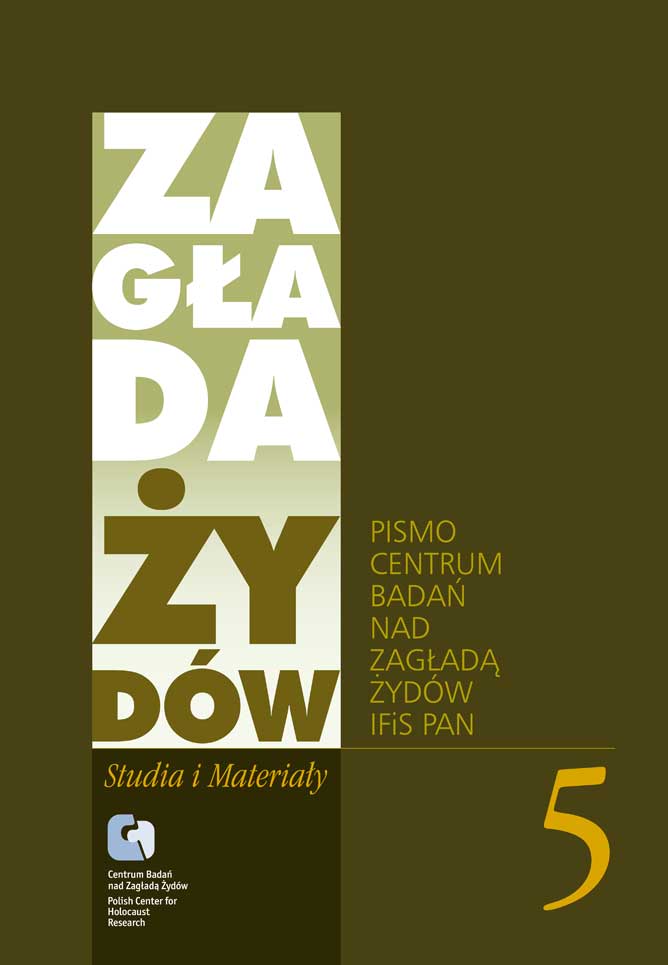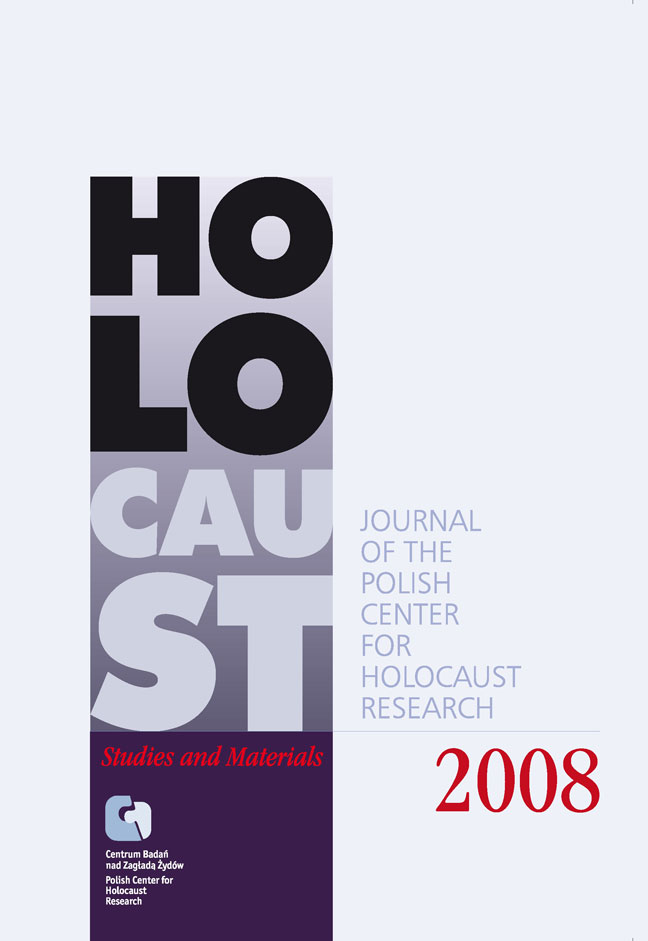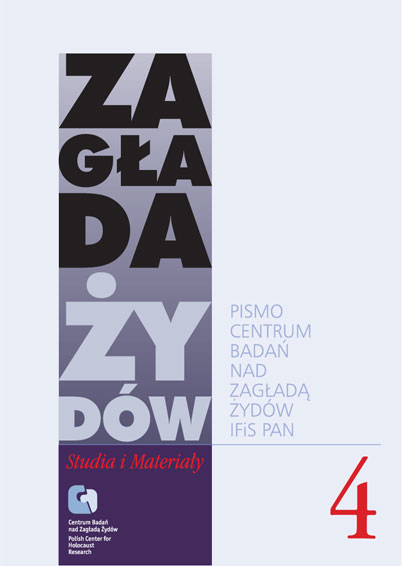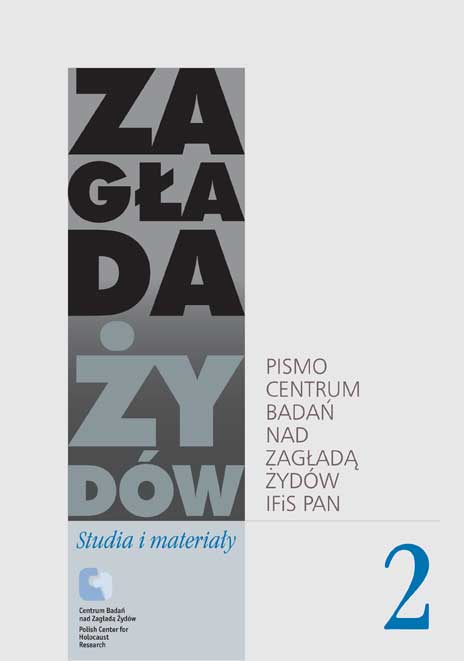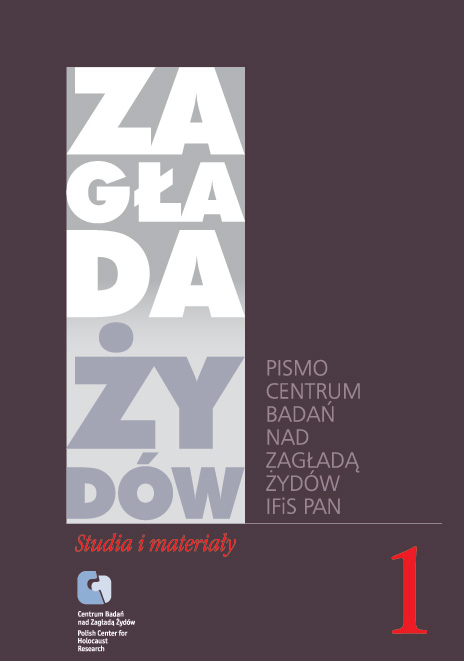Archives
This issue of the journal presents a comprehensive selection of texts devoted both to key anniversaries and to the latest directions in Holocaust research. It opens with a tribute to Marian Turski and a thematic section, “Neighbors After 25 Years,” in which contributors examine the international reception of Jan T. Gross’s book and its impact on scholarship and public debate. The “Studies” section includes articles on the microhistory of the Holocaust and on the functioning of Jewish institutions in the Lublin district under German occupation. The “Materials” section features two edited source records, while “Holocaust Commemoration” focuses on reflections concerning memory of the Holocaust in Lublin. The volume concludes with reviews of recent publications and Piotr Forecki’s analysis of contemporary “anti-Zionist” narratives and their influence on current discussions about the Holocaust.
The leading theme of this issue is the encounter between psychology and history. Michal Bilewicz and Karolina Marcinkowska describe the evolution of understanding the behavior of victims, perpetrators and witnesses in social psychology. France Grenaudier-Klijn analyzes the origins of Anna Langfus' writing, and Stanley S. Seidner examines the occupation traumas of David Wdowinski. Katarzyna Prot-Klinger and Krzysztof Szwajca take up the topic of survivor therapy. The issue also includes an analysis of the attitudes of Pius XII and Vatican diplomacy toward information about the extermination of Jews in 1942-1943, by Monica Stolarczyk-Bilardie.
The volume comprises two thematic blocks: The 80th-anniversary commemoration of the Warsaw Ghetto Uprising and postwar settlements. In relation to the anniversary, we feature articles by notable scholars, including Havi Dreifuss on the Jewish Combat Organization Command, Jacek Leociak on anniversary commemorations, Pola Elster's and Hersz Berlinski's notes from 1943-1944, and a contribution by Noam Rachmilewicz focusing on the archives of the Jewish National Committee.
In the Studies section, Markus Roth delves into the extraditions of war criminals and trials of officials, while Dariusz Libionka examines postwar proceedings against policemen, officials, and others from the Kreis Miechow. Tomasz Frydel sheds light on the role of village leaders in the occupation system, and Ewa Koźmińska-Frejlak explores women's experiences and the adjudication of crimes against them by the Social Court.
The current issue of our journal is devoted to the broadly understood problem of escapes from the Holocaust. The disgraceful attack by Vladimir Putin's Russia on Ukraine and its people has made this issue dramatically topical. Since the beginning of the war on February 24, 2022, Poland's borders have been crossed by hundreds of thousands of refugees from occupied areas and threatened by terror, unprecedented in the 21st century in Europe, on the part of the aggressors.
The choice of escapes as the most important topic of the volume was dictated not by the current context (Russian aggression could not have been predicted when designing this volume), but by the importance of this issue, which provoked various research questions. They concern, for example, the ways and possibilities of estimating the total number of ghetto escapees and their chances of survival.
The main topics of the new volume of our Journal “Holocaust Studies and Materials ”are holocaust kitsch and abuses in portraying the Holocaust. Researchers representing various fields of science and presenting the problem from many perspectives took the floor in the debate. The volume includes texts analyzing the image of the Holocaust in computer games and social media, as well as in literature.
A separate block of materials concerns the work of Artur Żmijewski and his film "Berek", which became the subject of heated discussions entangled in political games. For the first time in the "Holocaust Studies and Materials", we present a unique collection of photos taken during the production of "Berek".
In addition to the main topic, this issue includes a new voice in the discussion on the attitudes of the "Blue Police" towards Jews, the results of research on the post-war plunder of the Treblinka extermination camp, and an article about the fate of Roma and Sinti resettled to the Łódź ghetto.
The main theme of the 16th issue of our annual is the 75th anniversary of the liquidation of the Łódź ghetto. We publish, for instance, Marian Turski’s testimony, Andrzej Czyżewski’s study on the historical policy of the communist authorities of Poland concerning the ghetto, Ewa Wiatr’s article about youth groups in Marysin, and Irmina Gadowska’s text about painters. Adriana Bryk discusses the history of the the postal services in the ghetto, Krystyna Radziszewska describes the lot of European Jews deported to the ghetto, Andrzej Grzegorczyk discusses the organization of the first wave of deportations from the ghetto, Jacek Walicki compares the functioning of the ghetto archives, and Sylweriusz Królak analyzes descriptions of walks in the two ghettoes. We also publish Viktor Hahn’s ghetto diary and Mordechaj Żurawski’s testimony.
This issue is published in cooperation with the Jewish Research Center of the University of Łódź. Ewa Wiatr and Adam Sitarek joined our editorial staff as guests.
The studies and the edited primary sources included in no. 15 of our annual focus on figures of religious thinkers, rabbis, and also religious Jews active during the war as well as their writings, which our authors comment on and interpret. Havi Dreifuss of Yad Vashem makes us familiar with Matys Gelman — the unknown leader of an unknown Hassidic movement during the Holocaust. Daniel Reiser writes about rabbi Kalonimus Kalman Szapiro’s famous sermons delivered in the Warsaw ghetto. Barbara Krawcowicz presents the theodicean threads in the war-time sermons of Bratislavan rabbi Shlomo Zalman Unsdorfer. Adam Kopciowski discovers the subject matter of God and the Holocaust in letters of rabbi Hersz Majlech Talmud from the Lublin ghetto. Adam Sitarek analyzes a letter of Jakub Szulman from Grabów…
Number 14 of our annual was published in a year with two important anniversaries — the 75th anniversary of the uprising in the Warsaw ghetto and the 50th anniversary of March 1968. The text penned by one of the most important living Holocaust scholars, Yehuda Bauer, bases on the former event. Bauer’s article, on the one hand, reminds us about the history of the uprising and sums up the latest scholarly findings, and on the other hand, places the Warsaw Jews’ resurrection in the context of Polish-Jewish relations and references. The author also discusses the processes of the instrumentalization of memory of the uprising and its use to meet summary objectives both in Israel and Poland.
This volume contains a selection of articles from Holocaust. Studies and Materials published by the Centre for Holocaust Research during 2014–2016. This is already the fourth English volume intended to familiarise the foreign reader with the newest Polish research on the Holocaust and also introducing unknown documents from Polish archives into scholarly circulation. The previous editions were published in 2008, 2010, and 2013.
The several dozen texts in this volume are arranged in an order modelled on the Polish-language version, though it was decided not to include a selection of the reviews printed in our periodical.
The first section, Studies, contains six texts. The article opening this volume is Jan Grabowski’s text that reveals new facts regarding the March 1944 discovery of the bunker where Emanuel Ringelblum, the Oneg Shabbat founder, was hiding. This study sheds new light on the mechanism of tracking down Jews in Warsaw. Grabowski’s analysis of post-war court files proves that specialised groups of criminal police functionaries played an extremely active role in those efforts. Barbara Engelking’s study, which also regards the Warsaw context, discusses the help provided to about a dozen Jews by a pre-war avowed anti-Semite. It is not a simple and unambiguous case, however, because after the war that Pole was tried for having acted to the detriment of other Jews. Another of our authors, Dariusz Libionka, presents the reactions of the Polish Government in exile, its consulting body, the National Council of Poland, and the Polish press published in London to the struggle waged by the Warsaw ghetto in April and May 1943. Libionka analyses the reasons for the classification of the initial news from the ghetto, and the Polish authorities’ and also the émigré political circles’ distance towards the fighting Jews. He also discusses the fact of the propaganda taking advantage of Szmul Zygielbojm’s death and Jewish resistance.
The article devoted to the post-war violence against Jews in the Podhale region of Poland deserves special attention. This topic has long inspired heated emotions and has become radically politicised. Suffice it to say that Józef Kuraś ’Ogień’, whose subordinates conducted most of the massacres of the Jews who had just survived the Holocaust, was praised as one of the greatest commanders of the post-war anticommunist underground. One should bear in mind that in 2006 the late Polish President, Lech Kaczyński, ceremonially unveiled Kuraś’s monument in Zakopane. Recreating the course of the consecutive crimes, the author of the text, Karolina Panz, focuses not only on reconstructing their mechanism and perpetrators, but also on the biographies of the victims, convincingly proving that they had nothing to do with communism.
The last two articles in this section were written by Nawojka Cieślińska-Lobkowicz and Elżbieta Janicka. The former concerns organised looting of works of art owned by Jews in the General Government, while the latter discusses the politics of memory and the ways of commemorating Polish and Jewish martyrology in Warsaw. The analysis conducted by Elżbieta Janicka reveals why the monument devoted to Poles murdered in the East during World War II was erected on the former Muranowski Square, where the fiercest fighting in the ghetto went on in April 1943.
Among the texts included in the From Research Workshop section the article about Witold Pilecki is particularly recommended, who has recently become one of the most popular Polish national heroes. According to the dominant narration, Pilecki voluntarily let the Germans deport him in the autumn of 1940 to the Auschwitz concentration camp, which was under construction. The author of this text, Ewa Cuber-Strutyńska, proves that the matter is more complicated, pointing out the discrepancies between different accounts of Pilecki’s arrest. Similarly, the issue of the role of Pilecki’s reports in the transfer of information about the extermination of Jews in the Birkenau gas chambers remains unclear. As we had expected, this text received a particularly cold welcome from nationalist publicists.
In the Materials section we publish the diary of Chaim Einhorn, who was hiding in the Warsaw ghetto, correspondence of members of the German military and police formations that participated in the extermination of the Jews (intercepted by the Home Army intelligence service), and last but not least, reports from several ‘blue’ police stations written during the spring of 1943 (including the period of the Warsaw ghetto uprising).
A separate section is devoted to the POLIN Museum of the History of Polish Jews, opened in 2014. We present the voices of both the creators and the critics of the individual exhibition room’s conception and content.
In the last section, Controversies, overviews are published of the newest publications and actions regarding the Righteous among the Nations. From the point of view of the Polish ‘historical policy’, which strives to subject historical research to political requirements, this is the subject matter most susceptible to manipulations and most often exploited.
Number 13 of our scholarly journal Holocaust Studies and Materials, published by the Polish Center for Holocaust Research of the Institute of Philosophy and Sociology of the Polish Academy of Sciences, is almost 900 pages of pioneering studies, materials, overviews, and editions of unknown primary sources. The main threads in this issue are two anniversaries. The first one is the 75th anniversary of Aktion Reinhardt, that is the extermination of Jews on Polish lands, and the other is the 70th anniversary of the establishment of the Jewish Historical Institute. We devote a range of texts to these topics. Same as articles about the structures of the Jewish Social Self-Help and the Holocaust research carried out by the Jewish Historical Institute during Stalinism, these texts present largely-unknown, new historical findings. This number is supplemented with texts about, for instance, the role of auxiliary formations in the Holocaust in Eastern Galicia and Lithuania and the results of the pioneering ethnographic research on memory conducted since the 1970s. It also contains reviews of newest publications and commentaries on current events.
The common denominator for the articles published in number 12 of our annual is the European context. The texts published regard, for instance, the engagement of the French Church in sheltering Jewish children (Eliot Nidam Orvieto), the campaign within the framework of which they were sent to England (Anna M. Rosner), Sonderdienst’s activity in the General Government (Peter Black), and also the perception of Jews by German civilians working in the occupation apparatus (Stephan Lehnstaedt). We recommend predominantly Marta Janczewska’s article, which analyzes Jürgen Stroop’s reports and interprets the official German language describing the Jewish death. We also present historical figures: Frankenstein — a sadistic policeman from the Warsaw ghetto (Jan H. Issinger), the Gutnajer antique dealers (Nawojka Cieślińska-Lobkowicz), and political activist Eleazar Grünbaum (Jacek Dehnel). In the Points of View section we publish, for instance, an article which interprets the Polish literature about the Holocaust as a horror (Przemysław Czapliński), texts inspired by reading Neumann’s Behemoth (Raul Hilberg), and a text which compares fascism with communism in light of that book (Marcin Kula). Another comprehensive article discusses Mirosław Tryczyk’s famous book Miasta śmierci (Krzysztof Persak).
In the introduction the editorial staff points to the danger stemming from the increasingly boldly articulated promises of radical actions in the sphere of politics of memory, particularly the threat to scholarly research and the danger that the subject matter of the Holocaust could become instrumentalized. From among the texts published in the Studies section, particular attention should be paid to Karolina Panz’s article devoted to the phenomenon of post-war violence in the Podhale region. The author analyzes the course and mechanism of those crimes but focuses on discussing their victims. The studies that follow regard the broadly defined subject matter of help and rescuing: the evacuation of Jewish children from the USSR to Palestine during 1942‒1943, the survival conditions in occupied Belgium, Holland, and France, aid to Jews in Vichy France, and the paradoxes connected with hiding Jews in Warsaw. This section is supplemented with a study on a Dutch Nazi who conducted organized looting of works of art. In the Profiles section, we present the biography and legacy of another Holocaust historian — Filip Friedman, while in the Materials section we print an unknown diary about hiding on the ‘Aryan’ side.
We give our readers no. 10 of the Holocaust Studies and Materials annual, published since 2005 by the Polish Center for Holocaust Research of the Institute of Philosophy and Sociology of the Polish Academy of Sciences. These ten years are conducive to syntheses, balances, and summings-up. In this issue, we are trying to find answers to the questions born from a reflection on the last ten years of research on the Holocaust in Poland. Justyna Kowalska-Leder and Bartłomiej Krupa write about the Holocaust literature and historiography, while Piotr Forecki discusses the celebrations of anniversaries of the uprising in the Warsaw Ghetto.
Number 10 of our annual not only offers reflections occasioned by the even anniversary of our periodical, but is also devoted to Warsaw to a large extent. In his study Jan Grabowski uncovers interesting and unknown facts about the Warsaw Kripo, which was tracking down Jews in hiding; Dariusz Libionka writes about ‘Polish London’s reactions to the uprising in the ghetto, Nawojka Cieślinska-Lobkowicz discusses an ‘antique store’ which operated between the ghetto and the ‘Aryan’ side, while Elżbieta Janicka brings up the symbolic topography of the terrain of the former ghetto. We also write about people connected with Warsaw: Israel Gutman (described by Havi Dreyfuss) and Ruta Sakowska (by Tadeusz Epsztein), both of whom died shortly before the publication of this issue, as well as Hersz Wasser (by Katarzyna Person) and Józef Kermisz (by David Silberklang). In this issue, we also bid farewell to our colleague Robert Kuwałek, who died suddenly.
This volume contains texts published during 2011–2013 in the Zagłada Żydów. Studia i Materiały yearly published by the Polish Centre for Holocaust Research, Warsaw. The previous volumes of the English edition were published in 2008 and 2010. The purpose of Holocaust. Studies and Materials is to present the most recent research undertaken in Poland, primarily that based on source materials kept in local archives, in the hope of introducing them to academic circulation. The intention is also to familiarise the foreign reader with the current discussions and disputes in Poland regarding the subject matter of the Holocaust and Polish-Jewish relations.
Four of the texts published in this volume deal with the perception and treatment of the Jews, escapees from the ghettoes and camps, by the partisan detachments of the Home Army and other underground organizations. This subject matter continues to be highly controversial. For instance, after a German TV channel had transmitted the miniseries Generation War [Unsere Mütter, unsere Väter], which shows anti-Semitism spread in the ranks of the Home Army, there was a wave of criticism in Poland.
The studies presented in this volume do not offer a comprehensive analysis of the complex issue of the attitude of the Polish underground resistance to the extermination of the Jews they witnessed. Instead, the studies are multi-faceted analyses of murders committed on the Jews during 1942–1944. The first text, written by historian Alina Skibińska and ethnographer Joanna Tokarska-Bakir, discusses the murders committed on the Jews by members of the famous partisan detachment of the Home Army operating in the Kielce area. The victims included a Jewish family, its Polish helper, who years later received the Righteous among the Nations medal, and a member of a Home Army detachment, who was murdered after his anti-Semitic companions had discovered his Jewish origin. One of the effects of the publication of that text was that the AK officer who cooperated with the authors was excluded from a combatant organization. Dariusz Libionka’s text is the most recent voice in the discussion, which has been proceeding in historical literature, regarding the case of the murder of a group of escapees from the forced labour camp on Lipowa Street in Lublin, who were Polish soldiers of Jewish origin taken prisoner in September 1939. Libionka’s careful reading of the source materials enabled him not only to reconstruct the facts, but also to reveal the manipulations perpetrated in the 1990s by some Polish historians. There is no doubt that the massacre was committed by a nationalist group, which was soon incorporated into the National Armed forces (a right-wing organization, not affiliated with the mainstream Home Army). The “Materials” section presents studies regarding the murder committed by members of the local Home Army network on a few Jews hiding in a small village in the Opatów county and the execution of a few dozen escapees from the forced labor camp in Skarżysko-Kamienna conducted by a Kielce detachment of the Home Army shortly before the liberation in August 1944. The article by Anna Bikont, who inspected the scene of the said crime in 2011, is a postscript to the latter text. All authors of the texts reconstruct the course and mechanism of the events as well as their wider context. They also wonder to what extent those anti-Jewish actions resulted from the orders and to what extent they were a consequence of the demoralization of some members of the underground. They also try to discover how common such incidents were.
The main subject matter discussed in this volume is the use of primary sources in Holocaust research. This is the topic of B. Engelking’s study on dreams, P. Filipkowski’s study on oral history archives, and H. Drefus’ text about writings of religious Jews. The next texts regard post-war reckonings in Poland (A. Prusin writes about the trials of Nazi criminals before the Supreme National Tribunal and A. Kornbluth about the court proceedings under the ‘August decree’), France (J. Grabowski discusses the reckoning in the Paris police), and Germany (J. S. Legge analyzes the treatment of Nazi crimes using the example of the massacre of American soldiers in Malmédy).
On the occasion of the 70th anniversary of uprisings in the ghettoes and camps, we introduce a special bloc of materials. Among them are: Icchak ‘Antek’ Cukierman’s study on the Jewish Fighting Organization (ŻOB), writings of Chajka Klinger, a member of Hashomer Hatzair in Będzin, as well as Jürgen Stroop’s testimony given in July 1951 before the Provincial Court in Warsaw. The subject matter of resistance is also the main topic of the conversation with Israel Gutman, who has recently died.
This volume features a bloc of materials devoted to the 70th anniversary of Aktion Reinhardt: Rachela Auerbach’s unique reportage Na polach Treblinki [on the fields of Treblinka], written in 1946 in Yiddish and only now translated into Polish, the revealing study penned by Caroline Strudy Colls from Staffordshire University in England about her archeological works conducted at the former death center in Treblinka. The remaining texts published in this volume revolve around several topics such as forced labor camps, the sheltering of Jews and the moral dilemmas associated with that, collaboration and meting out justice to Holocaust perpetrators, German Jews in the Łódź ghetto, human remains at the Auschwitz-Birkenau Museum, and photographic representations of the Holocaust experience. On the occasion of the Year of Korczak we present a previously unpublished set of his letters written at his orphanage during 1940‒1941 and the history of Korczak’s texts that survived the ghetto.
Volume 7 of the scholarly journal of the Polish Center for Holocaust Research revolves around several main themes, the most important of which is varied but often also mythologized issue of the attitude of various Polish underground organizations to Jews, their annihilation, and the subject matter of help or place in new, independent Poland.
The subject matter of this volume of the scholarly journal of the Polish Center for Holocaust Research revolves around several main themes, the most important of which is the subject matter of the instrumentalization of the Holocaust and ‘Holocaust kitsch’. Trying to paint a most complete picture possible, the texts making up this volume discuss various forms of kitsch filtering into the representations of the Holocaust in art, film, literature, and, last but not least, television. This reflection is relatively well-rooted in the contemporary humanities. The subject matter of the broadly-defined abuses in the journalistic, literary, and artistic representation of the Holocaust has been an object of brilliant and at the same time bitter analyses of the form of the presence of this experience in the public space. They reveal the phenomenon of the McDonaldization of the Holocaust, which is spreading like cancer, its political instrumentalization, ideological manipulation and commercialization. This tendency is manifested in the spheres of culture intended as high culture — in museums, film, theatre, literature, as well as in pop culture, television, and the Internet.
The present issue of “Holocaust. Studies and Materials” continues the tradition which started with the publication of our first volume, two years ago. The articles and studies presented in the current volume represent a selection of materials which appeared in volumes 4, 5 and 6 of the Polish edition of “Zagłada Żydów. Studia i Materiały” – the sole Polish-language revue entirely devoted to Holocaust issues.
We open with two studies by Dariusz Libionka. The first one concerns the issue of help offered to Jews by Poles. This is, quite likely, the most controversial issue in contemporary Jewish-Polish relations, and a theme that is constantly debated in the media. Libionka offers the first comprehensive and well-informed overview of the “help” discussion, starting with early post-war writings, through the miserable post-1968 studies deeply tainted by the anti-Semitic campaigns, and going all the way to recent years, when historians working under the aegis of the IPN (Institute of National Remembrance) set out to document the alleged war-time sympathy of the Poles toward their Jewish co-citizens. Libionka’s second essay touches on an equally delicate theme – the war-time actions and inactions of the Polish Catholic hierarchy. Did the Church do enough? Did the bishops, cardinals and the primate hear the pleas of the dying Jews? What was their reaction, when faced with this unprecedented tragedy? These, and other questions, are discussed by the author, who has recourse to various previously unknown documents taken from the Polish archives. Marcin Zaremba describes one of the most spectacular – if we may use this expression – phenomena of occupied Poland: the all-encompassing “szaber,” or smuggling, which by 1945 had become a way of life for large segments of Polish society. Barbara Engelking brings to light one of the most important diaries written by a Jewess in hiding. Fela Fischbein’s diary (long overdue for publication) is a powerful, moving account of one woman’s resilience, resourcefulness, temerity and boundless courage in the face of horrible odds. Using Fela’s experiences, Engelking sets out to show the complex, unpredictable, and often treacherous relationships between Jews in hiding and their Aryan hosts. Aleksandra Ubertowska leaves the Polish scene, and writes about the universal problem of representation and misrepresentation of the Holocaust in literature. The remaining essays, materials and research texts have one thing in common: they bring to light little known (or unknown) historical and literary evidence. They also include several unique and new testimonies which complete the volume. The texts are in part based on recently uncovered archival sources, and in part on new approaches which help us to redefine our field of study. It is our hope that this volume will further underline the crucial role of continuing Holocaust-related research. It is equally important, however, that this book shows clearly that there is no understanding of Polish history without understanding the history of the destruction of the Polish Jews.
This issue concentrates on the attitude of the Catholic Church to the Holocaust in German-occupied and German-controlled Europe, with a main focus on Poland.
Writing about the history of the Holocaust in Poland, and in Polish, carries with it a very peculiar set of duties, obligations and challenges. There are few issues in Polish history that reverberate through the nation with such a force and whose ongoing discussion is able to have an immediate and profound impact on the national self-perception. The recent discussions surrounding the publication of Jan T. Gross’ books are a convincing proof thereof. On the other hand, the issues related to the destruction of the Polish Jewry have been among the most forgotten, falsified and manipulated events of the recent past. As discussed in recent decades, the Holocaust became an addition, rather than an essential and defining part of the Polish historical writing. And these were the reasons why the Polish Center for Holocaust Research has been created in the first place The members of the Center set out to bring back the history of the Holocaust into the center of the historical focus while, at the same time, trying to make it an integral and inalienable part of mainstream Polish history.
The publication of this volume marks an important chapter in the history of the Polish Center for Holocaust research. Since its creation in 2003, the Center has published a number of books written by its members. It has also published translations of crucial foreign publications previously unavailable in Polish. In addition to the published books, the Center has also published three volumes of its yearly revue The Holocaust Studies and Materials. Fourth volume is soon going to press, and will be available in the bookstores in the near future. Each volume has a thematic leitmotiv : an area of study which has previously been neglected by researchers. The first volume focused on methodological issues related to the history of the Holocaust. The authors analyzed the historical and epistemological potential of the available sources, while pointing to the pitfalls and challenges in the existing literature. The second volume shed light on the various aspects of the phenomenon of collaboration under the occupation; both on the “Aryan” and on the Jewish side. The third volume turned its attention to the fate of the smaller ghettos, places often overlooked in the academic writings. The fourth, current, volume sets out to explore one of the most hotly debated and most contentious questions in the area of Polish-Jewish studies; namely the problem of Polish-Jewish interaction and, more specifically the issue of helping and rescuing the Jews during the Holocaust in Poland. This English-language volume represents a choice of articles published in the first three issues of the Polish version of the Holocaust Studies.
The fourth volume of a scholarly journal published by the Polish Center for Holocaust Research focuses on topics connected with help provided to Jews during Shoah on the occupied Polish lands.
Third volume - dovoted to the Holocaust and the Polish-Jewish relations in the provinces, with particular emphasis on small towns and their ghettoes.
Volume devoted to the issue of collaboration and cooperation with the German occupier (by both Poles and Jews), together with the complicated issue of post-war account-settling.
First volume devoted to the issue of Polish-Jewish relations during World War II.
 English
English
 Język Polski
Język Polski


